Introduction: In this article, Gena Philibert-Ortega describes something once common but now incomprehensible to us: the public all drinking out of the same cup! Gena is a genealogist and author of the book “From the Family Kitchen.”
Before the use of public drinking fountains, how did your ancestor get a drink of water when conducting business in a city, attending school, or riding the train? The recent pandemic resulted in most public drinking fountains being turned off, but we still had access to purchased bottled water or personal water containers. What did our ancestors do? In public they drank water from the “common cup.”
The Common Cup
What is the common cup? As our 19th century and early 20th century family conducted business, went to school, and traveled, they drank from a common cup. This was a single cup attached to a fountain or made available with a bucket of water. This cup could have been made from any number of materials (enamel, glass, metal, for example) and anyone wanting a drink of water could use it. The cup was used by numerous people for any length of time, and was not necessarily washed or sanitized.
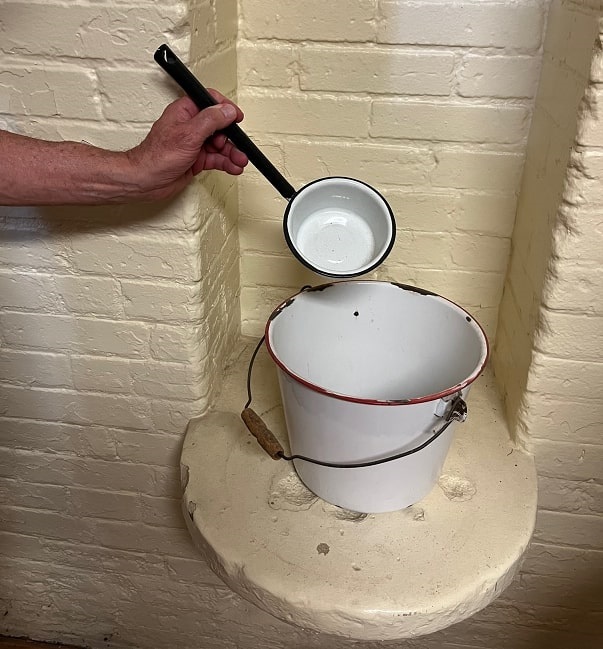
In the early 20th century, as knowledge of germ theory took hold, physicians and public health officials became concerned about the threat that the germs and filth of a common cup posed to those who drank from it. The website Disposable American explains:
Dr. Samuel B. Crumbine, a Kansas public health physician, began the crusade to eliminate the common drinking cup after having an experience on a train. Crumbine was traveling with one of his tuberculosis patients in 1907. He watched his patient take a drink of water out the common drinking cup in the railroad car. He then watched as a young girl drank out of the same cup.
Appalled, Crumbine began campaigning to ban the use of common cups and other public utensils across the state. (1)
Against the Common Cup
As public health officials and the medical community started speaking out about the common cup and encouraging the public to use disposable or personal cups, communities started looking inward at their schools and other institutions. This 1910 newspaper article from Riverside, California, called for an investigation into school sanitation.
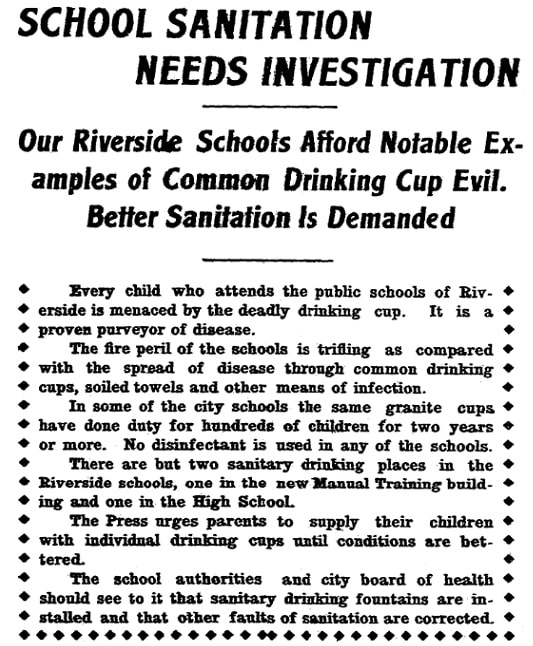
This article reported:
Every child who attends the public schools of Riverside is menaced by the deadly drinking cup. It is a proven purveyor of disease… In some of the city schools the same granite cups have done duty for hundreds of children for two years or more. No disinfectant is used in any of the schools.
It further reported:
In a number of the schools the common drinking cup is chained to the sink and heedless youth is accustomed to wash his hands over the vessel that the boy or girl next behind shall drink from.
The article discussed the problems with a common cup in spreading disease and recommended that sanitary drinking fountains, individual drinking cups, and other sanitation measures be implemented.
As more discussion centered on the public health issue pertaining to the common cup, individual municipalities started making changes and enacting laws. This 1913 Philadelphia Inquirer article mentioned that all railroads were doing away with the public cup. Philadelphia railroads were slated to provide free cups to passengers.
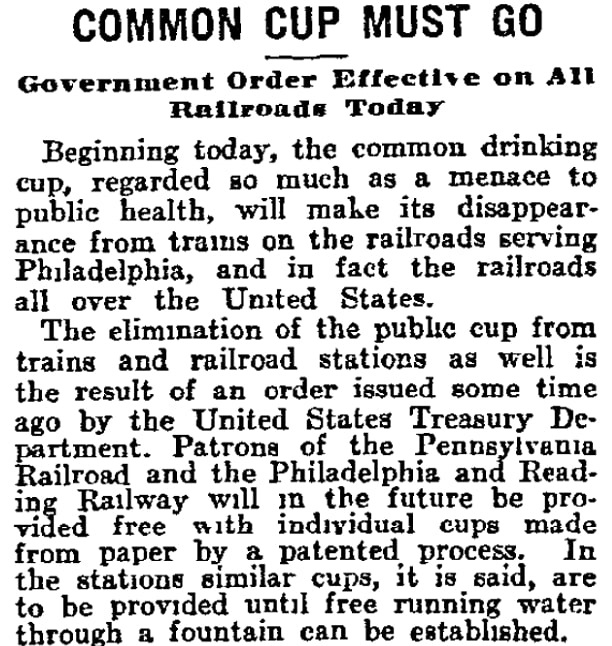
Not Everyone Wants a Cup
While it may seem obvious to us that one would not want to drink from a common cup, like any change, the changes that came with banning the common cup were not embraced by all. With the bans came new ways of getting a drink of water, including making your own cup out of paper or paying a few cents for a disposable cup. In this biting 1911 editorial from Cleveland, Ohio, the writer pontificated about how people will carry around individual cups so that they can quench their thirst. He wrote that women “will probably add individual drinking cups to their rapidly growing assortment of junk they carry in their handbags.”
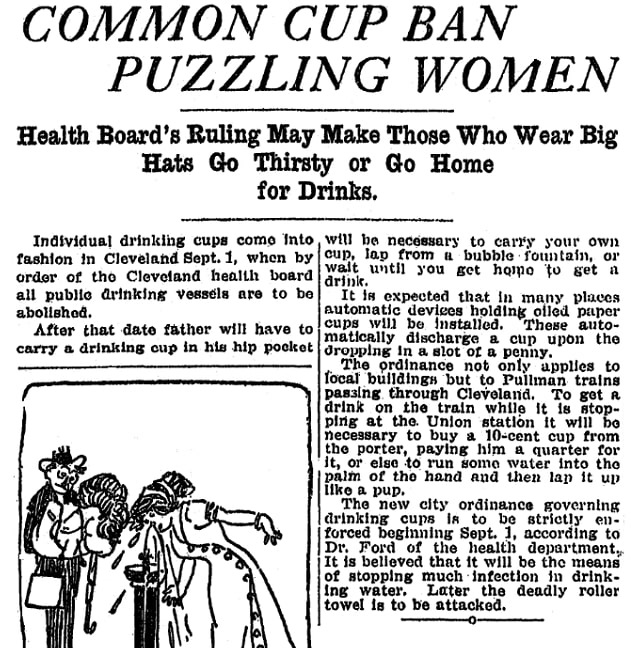
The End of the Common Cup
Some states were early adopters of disposable cups, like Kansas, who abolished the common cup in 1909. Dr. Crumbine deemed the abolishment of the common drinking cup as one of the most important acts accomplished by his department.
“With one-third of the deaths in Kansas every year caused by preventable diseases, all diseases which may be and are transmitted through common drinking cups, I regard the order of this department abolishing the public drink cup as one of the most important things the department has ever done.” (2)
By 1925 almost all states had enacted laws to end the use of a common cup. (3) In this newspaper article about insurance companies and disease, the message is clear: the way to stop the spread of some infectious diseases/illnesses is by enacting laws that focus on sanitary conditions. Insurance companies were looking ahead to sanitizing drinking glasses used in restaurants or recommending single use paper cups.
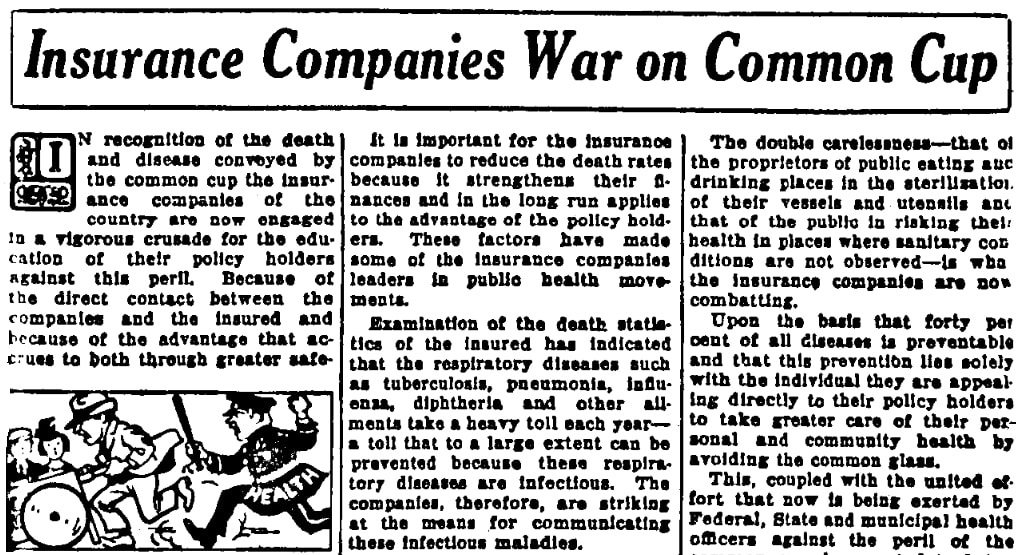
Today, we don’t give a second thought to drinking from disposable cups, bringing our own reusable containers, or buying bottled water – but the idea behind personal cups is one whose origin starts with the era of the “common cup.”
Explore over 330 years of newspapers and historical records in GenealogyBank. Discover your family story! Start a 7-Day Free Trial
Note on the header image: common cup and drinking bucket at the McCormick School Museum, Wichita, Kansas. Credit: Gena Philibert-Ortega.
_______________________
(1) “Beware the Common Drinking Cup – Reform and the Assault on the Common Drinking Cup,” Disposable America ( https://disposableamerica.org/course-projects/a-wholesome-drink/section-iii-beware-the-common-drinking-cup-progressive-reform-and-the-assault-on-the-common-drinking-cup/: accessed 3 January 2022).
(2) “Kansas State Board of Health, Part 3, Subdue the Wilderness and the Savage Inhabitants,” State Library of Kansas (https://kslib.info/Blog.aspx?IID=844&ARC=1015: accessed 3 January 2022).
(3) There are still some instances of the use of a common cup after 1925 in public and religious practices.

The object in the photo with the handle is called a dipper and was used in most homes and many public places such as the public well in towns. Some people used a gourd for a dipper, which is a dried melon-type plant in which the seeds have been removed and a hole cut in for dipping out water.
Yes, it was a dipper. It was referred to as “the common cup” along with actual drinking cups when we look at public health. Thanks, Betty Jean, for taking the time to comment!
Great story on the drinking cup!!
Thanks Janice! I appreciate it!
A similar article about the common communion cup used for the sacrament until the early 1900s would be interesting.
Good idea, thanks, Leslie!
I remember being allowed to crank the handle of a cistern to fill the water bucket kept on the enclosed back porch table with a dipper that the whole family drank from. The cistern water was really cool & tasted good — wonder what didn’t get filtered out as water came through a screen at the spout?
Good question, Marlyn. I’ve had other people talk about a common dipper used by a family. Obviously, that would spread germs, especially if a family member was sick, but I think sharing a dipper with a train full of strangers would be even more problematic.
Thanks for taking the time to comment.
During my 18-month Air Force assignment in Turkey (1969-70) I witnessed many times when people would purchase a drink of water or non-alcoholic beverage from a street vendor. The vendor usually carried a large vessel on his back containing the water. When a customer desired to purchase a drink he would tip the large vessel so that the water would pour into a glass or cup, hand it to the customer, and collect his fee. The glass or cup was attached to the large vessel by a rope or chain so he would not lose it. I never saw it washed!
Mike, a great example of how the common cup continued to be used in other countries. I read about one experience dating to the 1980s!
Thank you for sharing that.
In the 1950s my mother was treated for tuberculosis. Being a public health matter requiring a full investigation, it was determined that the common ladles she drank from in rural Alabama were the source.
Thanks for sharing that, Katie. That’s a good example of how the common cup was problematic for our families and how it could lead to their death or serious illness.